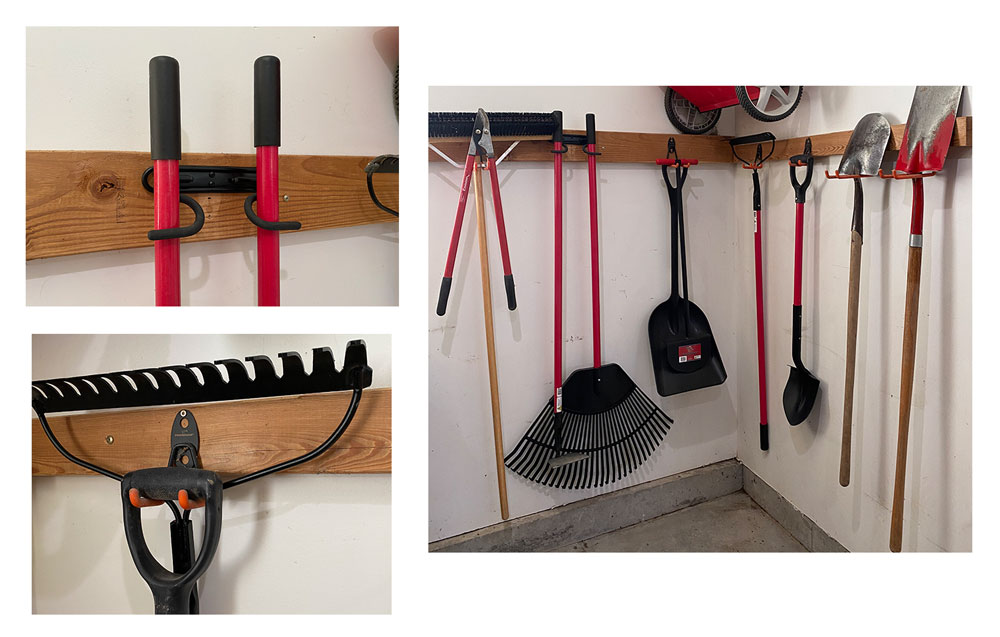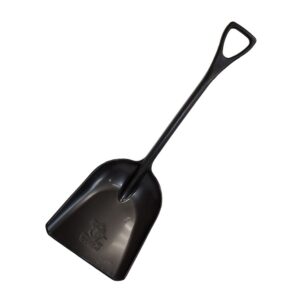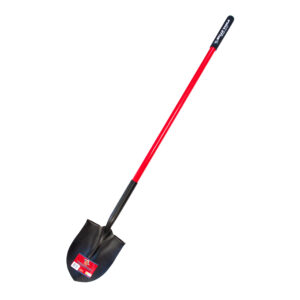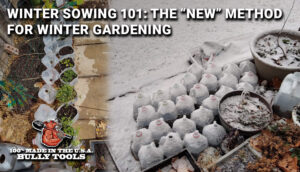Tool Storage 101: How To Properly Store Your Lawn & Garden Tools

Having a storage system for your long-handled garden tools is useful for two important reasons:
- A system means you’re more likely to store them properly after use.
- Tools last longer when you keep them off ground because they will require less maintenance when the tool head stays clean and sharp.
The nice thing about storing your tools at home is that there are as many ways to store as you have ideas—you can customize according to your needs. A variety of hooks and racks are available at hardware stores or projects can be found online. Figure out what you need first before ordering or you can make your own.
Setting Up Tool Storage for Long-Handled Garden Tools
Set your project up for success by performing the following steps to prepare your space:
- Choose a location to store your tools where they won’t get wet or dirty or where sharp heads can catch on limbs or clothes and cause a tripping hazard. An area on a wall is the best use of space, but containers work well, too. Heat can cause wood handles to split so cooler areas are better. But any protected space will work whether in a garage, a garden shed, or an outside wall, as long as it’s convenient so it’s more likely you will use it to store your tools.
- Measure the space to determine how much you can fit and how you should set up the area: available height, width, and depth. Keep in mind foot traffic, pets, available studs, doors, and other obstructions.
- Lay out the tools you need to store. If you have limited space, which tools can double up on the same rack? How many of each kind of handles do you have (D-grips, wooden, etc.) and how should they be stored? Do any tools need a specialty style holder? Which tools have larger heads and require more space? From this inventory and the measurements in step 2 you can draw out a potential set-up and create a list of the number/types/sizes of hooks/racks you’ll need for your space.
- Keep in mind that tools—especially if you have a lot of them—are heavy. Choose hooks, racks, wood, or containers that are strong enough to hold your tools; this includes screws that are long enough to truly anchor the holder (sometimes the screws that come with hooks aren’t very long). Tool holders meant for household items like brooms may not hold up over time, so are not recommended. If your chosen tool storage isn’t free-standing, it’s important to anchor any hooks or racks in wall studs because sheetrock only will not be enough, even with anchors. Using a separate piece of wood behind hooks has the added benefit of giving the tool heads more space to hang without pressing against the wall (see the “Individual Hooks” and “Wall Racks” examples).
Cleaning and Storing Long-Handled Garden Tools
How you take care of your tools as you store them is as important as storing them off the ground. Mud and dirt trap moisture and pathogens on your tools’ heads and handles and should be cleaned regularly to lengthen the usability of your tools. Also, storing them clean keeps existing problems from growing worse.
- During Spring and Summer Use—Sharpen as needed. You may need to Google local sharpening services in your area, or there are tools (such as grinders, drill attachments, or flat files) found in most home and garden centers for you to do it yourself. YouTube is a great resource for how to sharpen your tools safely. Spray any dirt off your tool after each use to prevent caking (use a wire brush if necessary) and don’t leave out in the sun or inclement weather.
- Winter Storage—If dirt is caked on, use a solution of bleach/water to dissolve the dirt (1 cup bleach to 1 gallon water), let soak 15 or so minutes, rise with clean water; if there is still dirt, use a wire brush. You can remove sap from tools with turpentine, and remove rust with vinegar. Oil if needed (typically exposed stainless steel) with linseed or WD-40. Wood handles can be given a quick sanding with 120-grit sandpaper then rubbed with linseed oil to weatherproof and prevent the wood from cracking.
Different Styles of Garden Tool Storage
There are many variations of the different kinds of tool storage, so consider the following a basic list of what you can create. Customizing your space according to your needs is the best possible solution.
Individual Hooks
Individual hooks come in many different styles and sizes to help you customize according to your space and tools.

Wall Racks
Wall racks like this hand-made space saving set-up with 2x4s and dowels can be purchased or made at home. Other styles have notches to hold handles. This frees up floor space but at the same time doesn’t stand out far from the wall.

Other wall racks can still use floor space, but the narrow profile of this rack using an altered pallet keeps tools corralled without being expensive.

Containers

There are a wide-variety of containers that can be used to hold tools, such as inexpensive reclaimed buckets, pots, or the pictured milk can. Make sure they are clean—and you may have to clean out regularly to remove bugs or other debris.

This homeowner used some scrap wood and PVC to create a container-like space to hold tools, utilizing what would otherwise be wasted space. It’s convenient, inexpensive, and simple, but effective.
Freestanding Rack

The pictured rack is one you can purchase, but there are also plans for DIY freestanding racks. They are convenient for moving around areas to keep tools available where needed.
Help Your Tools to Last
Certainly it’s important to purchase high-quality tools if you want them to last—this avoids sending cheap broken tools to the landfill every year. But even vintage tools can last if well-cared for, and that includes storing them properly. By making your storage system suit your tools, space, and personal habits, you are setting yourself up for lasting tool success.










